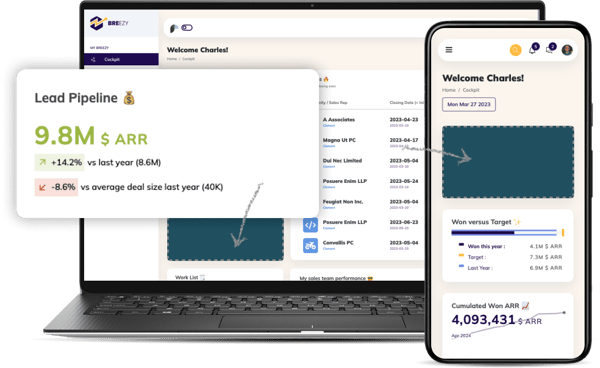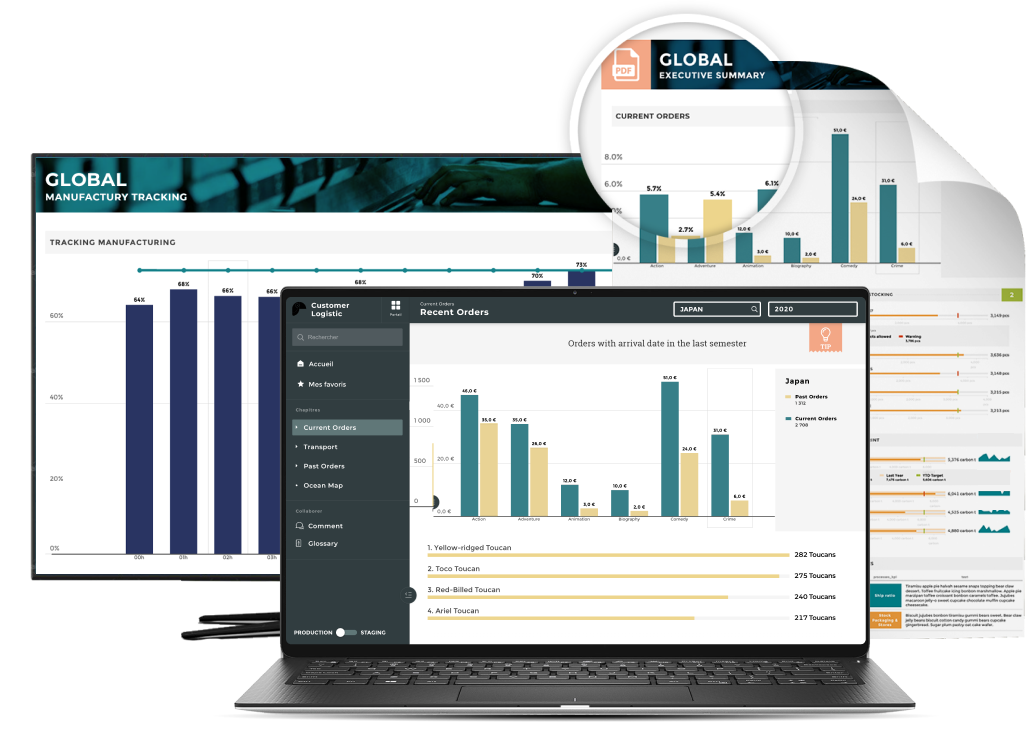
Why are Business Intelligence trends emerging?
Rapid Evolution of Business Intelligence
Keeping up with the rapid pace of Business Intelligence (BI) and the vast landscape of BI tools can be overwhelming and increasingly complex. Here are the market trends in 2025 so you may have a glimpse of what the future of business intelligence might hold.
Emerging Trends and Future Insight
As solutions and needs have evolved, new analytics and BI trends are emerging. Challenges in current delivery models require more tailored solutions, self-service models are evolving to meet user needs, and embedded analytics are expanding capabilities across work environments. Additionally, companies are exploring new ways to leverage large language models (LLMs).
With the expanding role of BI, the complexity of the solutions also increases. Providers and users must stay informed about the shifting landscape. In this article, we will explore five key trends in business intelligence (BI) for 2025. Our insights are backed by our Chief Product Officer (CPO), Adrien Deyhim, to provide you with not only neutral information but also expert opinions.
Trend 1: Diverse User Personas and Governance Challenges
Variety of User Personas in BI
As the market for BI tools grows, more companies are adopting business intelligence solutions across various industries and applications. An increasing focus on data-informed decision-making across companies drives the need for effective BI solutions. As BI tools continue to expand their features, businesses find more diverse uses for them.
Analytics and business intelligence (ABI) platforms attract a wide range of users with different personas, including analytics developers, business analysts, augmented consumers, and data scientists. Each user persona utilizes ABI tools for specific needs and objectives. Each user persona utilizes ABI tools for specific needs and objectives.
Importance of Effective Governance
This diversity necessitates the evolution of comprehensive ABI solutions that integrate capabilities from both data science and machine learning platforms. However, the proliferation of multiple ABI platforms within organizations raises governance challenges.
Different teams using various ABI tools to define metrics with unique business logic underscore the need for effective management and oversight in this multifaceted BI landscape.
Expert Insight: Adrien Deyhim
Adrien Deyhim,
Toucan Chief Product Officier, comments:
"I don't think it's beneficial for a product to become "comprehensive" for all personas. It usually fleshes out the product, making it more complex and diluting the design. In particular, I disagree on the value of blending data science use cases with analytics use cases. Unless they're different products within the same suite, but then again I don't see the point of rating a suite rather than a tool within the suite.
They talk a lot about multi-persona, but it's more of a use case-oriented approach, with potentially several personae working together. In my opinion, they're is confusion between use cases and personas."
Trend 2: Addressing Self-Service Challenges
Limitations of Current Self-Service Tools
Another key trend in 2025 is addressing challenges in self-service BI tools. Despite the increased capabilities of business intelligence solutions and common integrations, self-service tools have not proliferated as widely as expected.
Many organizations express dissatisfaction with the unmet expectations of self-service analytics, demanding more prebuilt analytics content.
As organizations recognize the limitations of self-service tools, they are actively seeking solutions that offer a more comprehensive and efficient approach. The trend indicates a growing emphasis on prebuilt analytics content to better serve users, reflecting a strategic pivot towards more robust and ready-to-use analytical tools.
Solutions: Prebuilt Analytics Content
To meet user expectations, it is essential to offer tools that are easy to implement across various user proficiencies and roles. Prebuilt catalogs of content and templates can simplify the use of self-service tools, reducing the burden of excessive setup processes.
As BI tools are adopted more widely and serve a broader range of roles and use cases, providers must ensure that users can easily generate accurate visualizations and dashboards from relevant data. In 2025, we may see BI providers enhancing time-to-value by offering more template capabilities, enabling users to quickly create useful reporting dashboards and embedded analytics.
Expert Insight: Adrien Deyhim
Adrien Deyhim adds
"The limited adoption of self-service solutions hints at the necessity for a shift towards pre-built content catalogs and templates to enhance autonomy. This recurring demand from our customers underscores the importance of providing ready-made resources to streamline and empower their data-driven initiatives."
Trend 3: The Rise of Embedded Analytics

What is Embedded Analytics?
As analytics and business intelligence tools, along with their integration capabilities, become more robust and complex, 2025 may see a continued trend of data democratization through embedded analytics.
Embedding analytics capabilities into a wider range of existing business tools is becoming increasingly important.
Benefits of Embedded Analytics
Data accessibility aims to empower data-driven decision-making across departments. Streamlining the process of data-informed action through embedded analytics makes it more accessible.
Integrating actionable analytics into enterprise solutions like CRM or ERP systems can significantly streamline workflows.
Expert Insight: Adrien Deyhim
Adrien Deyhim,
Toucan Chief Product Officier:
"I think it's a good idea to be able to start or finish a data flow in a digital workspace (what I interpret as the flagship tools of the business). Analytics tools are just details in our users' daily lives, and it's better to integrate them where they spend most of their time."
Trend 4: Simplifying with Prebuilt Analytics and Metrics
Importance of Prebuilt Solutions in BI
In 2025, the adoption of BI tools offering prebuilt analytics and metrics will be a key trend. These tools address challenges in self-service adoption and cater to a growing range of use cases.
Catalogs of prebuilt metrics and analytics simplify the process of gaining effective insights. Data accessibility is a common goal but often a barrier to adoption. To overcome this, providers might focus on enabling users to leverage their data without creating proficiency barriers or necessitating lengthy setup times.
Enhancing Usability and Adoption
The promise of Business Intelligence lies in the accessibility and democratization of data across departments, teams, and roles.
Prebuilt solutions enhance usability, making this a potential route for BI tools used across various roles, and ensuring users can quickly harness the power of their data.
Trend 5: Leveraging LLMs and AI in Business Intelligence
AI and LLMs in Business Intelligence
As companies strive for greater data accessibility in self-service solutions, leveraging AI systems like large language models (LLMs) for business intelligence is becoming a focus. However, AI faces several challenges that need addressing for effective implementation in BI.
One primary challenge is accuracy. LLMs must accurately understand queries, requiring reliable, well-structured data. This includes clean tables, strong naming conventions, and a certain level of data maturity within the company. Implementing LLMs in self-service BI tools necessitates systems that consistently understand and process queries accurately.
The Future of AI in BI: Structure and Preparation
AI might seem like the perfect solution for self-service BI, promising to alleviate the bottleneck created by data professionals and fulfilling business users' need for data-powered insights.
However, allowing individual users to create their own visualizations can lead to inconsistencies and undermine the goal of a unified data truth. Aligning all stakeholders around a single point of truth ensures focused discussions and better decision-making, which is a fundamental belief held by the team at Toucan.
The true potential of AI in Business Intelligence lies in improving the structure, architecture, and preparation of data, setting a solid foundation for analytics and BI tools to deliver valuable insights.
Looking Ahead to 2025
2025 promises to be an interesting year for business intelligence. As companies continue to find ways to leverage data more effectively, democratization efforts may fuel the drive for self-service BI options, though challenges in adoption remain.
BI providers will likely focus on tailoring their services to meet specialized uses while enhancing collaboration between different user types. Embedded analytics will help streamline data into existing workspaces, and offering more prebuilt solutions may address self-service challenges. Overcoming AI challenges in Business Intelligence will also be crucial.
If you’re looking to enhance your customer-facing analytics, we’re here to help. Do more than just present data — tell a story. Toucan’s embedded and customer-facing analytics can help you harness data effectively. To learn more or get started, get in touch today.





